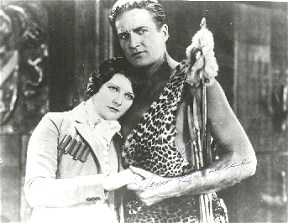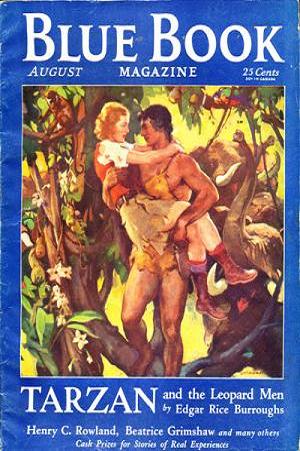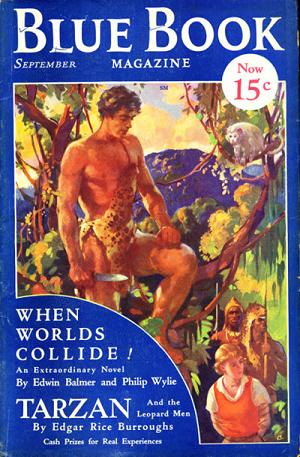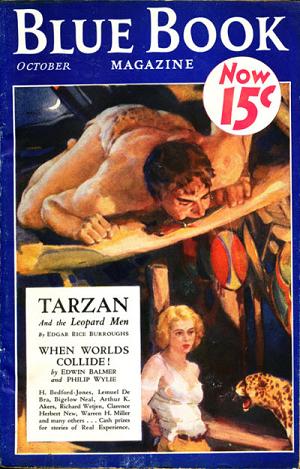
 This week we have a triple treat for all Edgar Rice Burroughs and Tarzan fans. From December 28th and 30th, 1932 and January 2, 1933 we have episodes 47-49 of the very first major syndicated radio serial, Tarzan of the Apes. Last July we showcased “Escape,” episode 46 of the serial. These short episodes ran around 12 minutes each, and we strongly recommend reading the fascinating capsule history of this vintage series here before continuing, for it’s an interesting story relating how ERB’s daughter Joan plays Jane, and her husband James H. Pierce (photo above left) plays Tarzan (and how ERB’s direct involvement in getting Pierce to play Tarzan helped launch the career of none other than Hollywood film star Gary Cooper).
This week we have a triple treat for all Edgar Rice Burroughs and Tarzan fans. From December 28th and 30th, 1932 and January 2, 1933 we have episodes 47-49 of the very first major syndicated radio serial, Tarzan of the Apes. Last July we showcased “Escape,” episode 46 of the serial. These short episodes ran around 12 minutes each, and we strongly recommend reading the fascinating capsule history of this vintage series here before continuing, for it’s an interesting story relating how ERB’s daughter Joan plays Jane, and her husband James H. Pierce (photo above left) plays Tarzan (and how ERB’s direct involvement in getting Pierce to play Tarzan helped launch the career of none other than Hollywood film star Gary Cooper).
The following episodes continue the story from “Escape,” where cannibals have captured Tarzan, Jane, her father, and their band of explorers. Tarzan and Jane have escaped, while her father and the others are still held captive and are recovering from the cannibals’ poison darts. Our story follows from there. All sorts of things hold the attention of the listener in these adventure-filled cliffhangers. We have a ritual rain dance that builds to a frightening climax (the almost Sfnal sound effects here are chilling as they grow in intensity), a mummy whose soul has escaped, Jane discovers who Tarzan really is when he shows her a few weather worn artifacts from his childhood, a giant snake and gorilla battle to the death, Jane comes into her own as a force to be recokoned with (and as much more than a helpless female in the dangerous African jungle), and Tarzan tries to save Jane from menacing crocodiles when an idyllic swim turns ugly and threatens her life.
As recounted in my notes for “Escape,” these early Tarzan radio adventures have a feel to them, an atmoshpere of crude, unpolished realism that the later 1950s Tarzan radio adventures fail to capture (though they have their own strengths). The sound track of the chanting, gibbering cannibals and other jungle sounds reminds one of the early Weissmuller b&w Tarzan movies. One can almost see the tribe of cannibals — pygmies with long spears and bone necklaces running through the thick jungle — as they threaten Tarzan and the band of white interlopers he guides. Marvelous stuff, and I hope you enjoy the following episodes and perhaps end up with a taste for them. (I also recommend listening to these episodes with headphones to better immerse oneself in the jungle experience, noticeably enhanced by the sound effects.) If you would like to hear more, simply indicate so by posting your request at Tangent Online‘s Facebook page here.
“Rain Comes” – December 28, 1932
Play Time: 12:09
“Jane Receives Greystoke Locket” – December 30, 1932
Play Time: 11:53
“Tarzan and the Crocodiles” – January 2, 1933
Play Time: 12:02
{Tarzan was everywhere in 1932-33: magazines, radio, and film. 1932 saw the release of the first of the classic Johnny Weissmuller & Maureen O’Sullivan Tarzan films, Tarzan of the Apes. This film also introduced Cheeta to the canon of Tarzan films and was played by the chimpanzee named Jiggs. Cheeta was added to these Weissmuller/O’Sullivan films but never appeared in any of ERB’s Tarzan novels. Tarzan and the Leopard Men was being serialized in Blue Book in late 1932, and of course the adventures of Tarzan, the first ever major radio serial, was airing 3 or 4 times a week in 1932-33. As an aside, on the science fiction front, notice below that the September 1932 Blue Book began its serialization of the classic SF novel When Worlds Collide by Edwin Balmer & Philip Wylie. What a hit those issues of Blue Book must have been back then, and what collectors’ items today!}
[Left: Blue Book, Aug. 1932 – Center: Blue Book, Sept. 1932 – Right: Blue Book, Oct. 1932]


